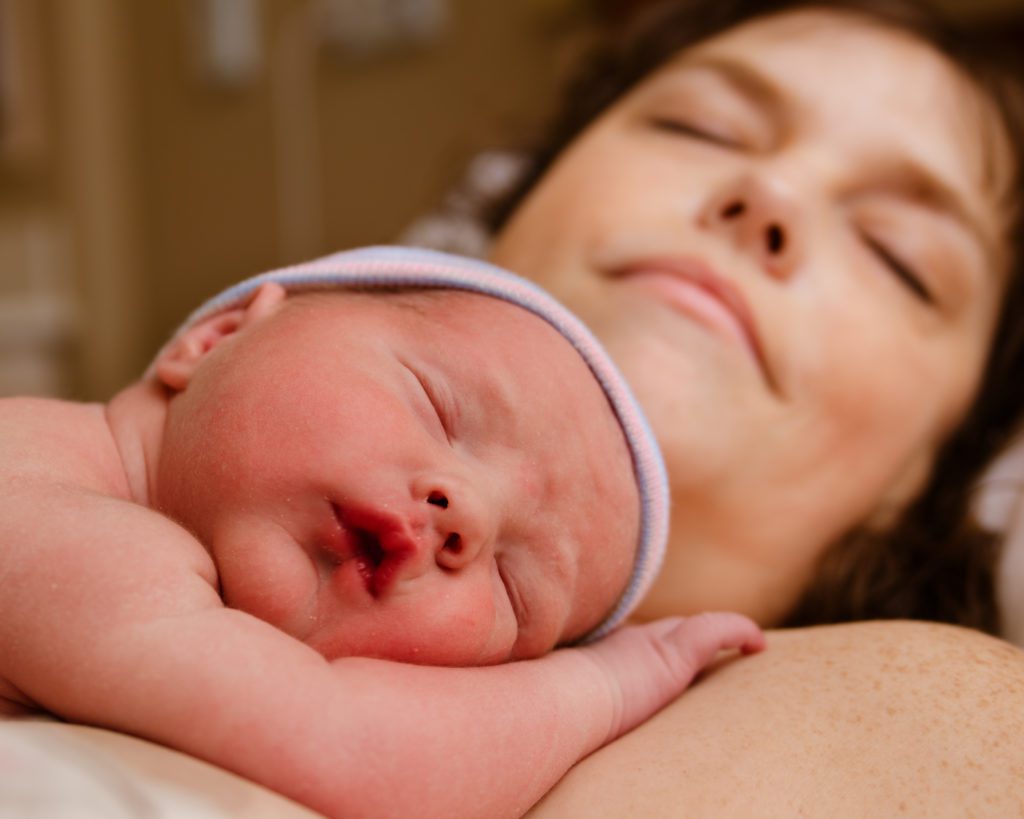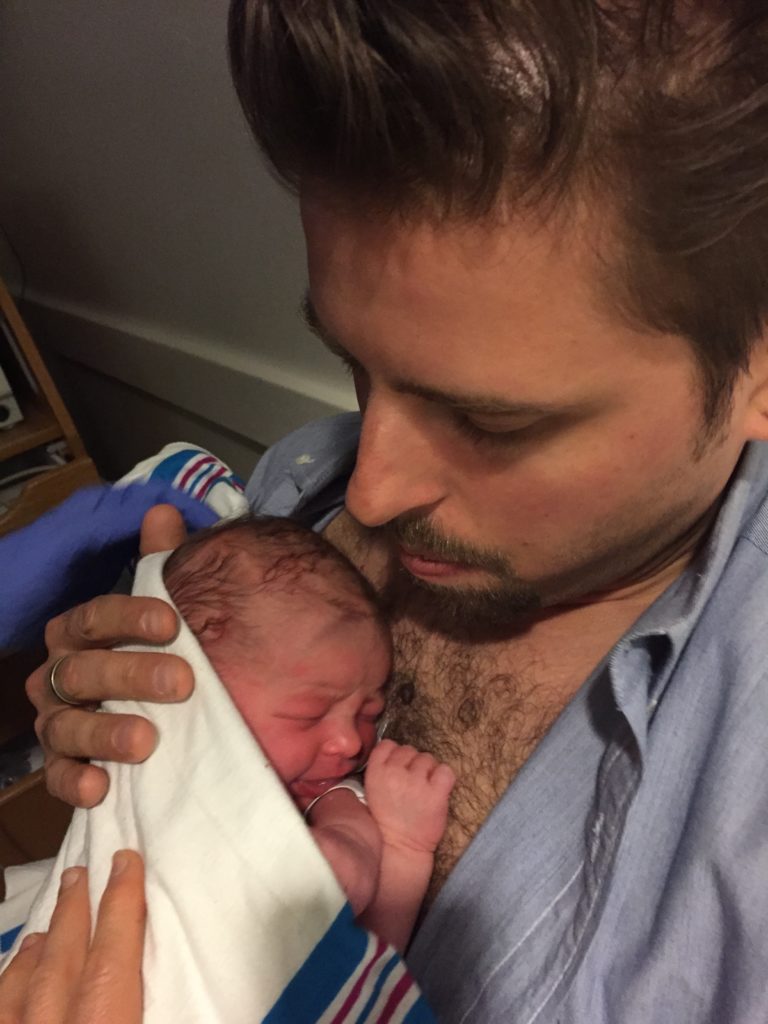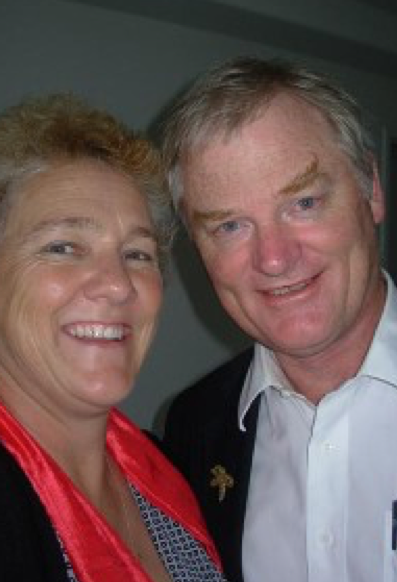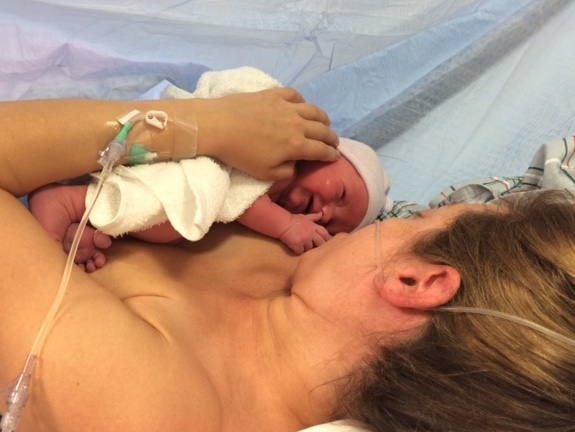Introducing “The Mindful Cesarean”
by Mary Esther Malloy, MA
While most placentas move as the uterus grows, this one didn’t. It was covering Renee’s cervix, obstructing her baby’s exit. Her doctor was certain that a cesarean would be the best and safest way to birth.
I have been a labor support doula for over a decade and like other couples I’ve worked with facing similar news, Renee and her partner struggled to orient themselves to the idea of a cesarean. We worked together to prepare. When the time came, they found their way through their baby’s cesarean birth, with peace and conviction. It was an honor to stand at their side and offer tools to enhance the natural hormones of birth and remind these parents, with an unwavering faith, that birth is sacred, no matter the circumstances.
In many parts of the world, one quarter to one half of all babies are born by cesarean. Too often women who birth by cesarean feel unprepared, frightened, traumatized or left with a sense of failure. As a doula, childbirth educator and fellow parent, I help couples who might deliver by cesarean ready themselves for the healthiest birth and recovery possible. To that end, I’ve come to frame the stages of a cesarean in the language of vaginal birth and suggest helpful practices for each stage to enhance the body’s felt sense of birth, thus activating the body’s endocrine system. Renee and other clients have urged me to make these tools and this perspective more widely available. And so I have launched “The Mindful Cesarean” project, a website with inspiring birth stories, practical tips and a downloadable toolkit featuring a cesarean birth visualization and other materials.
Optimizing Healthy Birth Hormones
“Modern medicine has the goal of helping mothers and babies survive. But nature wants more. Nature wants mothers and babies to thrive.” Dr. Sarah Buckley NYC 2014[i]
When labor begins on its own natural timetable and unfolds without interference, and when mother and baby remain together after birth, the intricate and long-evolved dance of childbearing hormones – oxytocin, beta-endorphin, prolactin, and catacholamines – can best orchestrate what nature hopes for: mothers and babies who are healthy, happy, well-adjusted, breastfeeding and bonded.
But sometimes interventions are needed. Sometimes, to survive, the tools of surgery are essential. And, when a cesarean is needed, aspects of birth are skipped that involve hormones that have been part of birth since human time began – and for ages before. With a cesarean, especially a planned cesarean, mothers and babies can experience lowers levels of these important hormones, including oxytocin, a powerful reproductive hormone.
The question I ask at “The Mindful Cesarean” is: when a baby must be born by cesarean, what can families do to optimize healthy birth hormones to best ensure that mothers and babies thrive? Throughout “The Mindful Cesarean” I detail many oxytocin-enhancing practices with the goal of helping families who birth by cesarean to what nature intends: mothers and babies who are healthy, happy, well-adjusted, breastfeeding, and bonded, even with the challenges of surgery.
I am pleased to share excerpts from “The Mindful Cesarean”: Dr. Nils Bergman on why skin to skin with a cesarean, and next week, his wife, Jill Bergman, on how. I am grateful for both Nils and Jill Bergman’s contributions to this project.
Our Species’ Best Medicine for Parenting a Baby Following a Cesarean
“Cesareans are good for many reasons,” says Nils Bergman, a South African physician and international promoter of Kangaroo Mother Care (KMC). “Yes, if medically indicated, cesarean is good. But the separation of a mother and her baby following a cesarean, now that is something altogether different.”[ii]
 Years ago in Zimbabwe, Dr. Nils Bergman introduced a protocol to keep low-weight preterm infants on their mothers, skin to skin, while every other aspect of care remained the same. He found that survival rates for these babies surged from 10 to 50 percent. Dr. Bergman later conducted a randomized controlled trial and found that preterm newborns in skin on skin contact with their mothers for the first six hours after birth were 100 percent stabilized. For babies in incubators, less than 50 percent had stabilized within six hours.[iii]
Years ago in Zimbabwe, Dr. Nils Bergman introduced a protocol to keep low-weight preterm infants on their mothers, skin to skin, while every other aspect of care remained the same. He found that survival rates for these babies surged from 10 to 50 percent. Dr. Bergman later conducted a randomized controlled trial and found that preterm newborns in skin on skin contact with their mothers for the first six hours after birth were 100 percent stabilized. For babies in incubators, less than 50 percent had stabilized within six hours.[iii]
Dr. Bergman became convinced that on-going skin to skin contact is what our species expects at birth, reflecting millions of years of evolution, and yielding significant physical and emotional health benefits for newborns and their parents. His findings have launched an international mother-baby skin to skin revolution. Dr. Bergman now lectures throughout the world about the neuroscience behind Kangaroo Mother Care. He is challenging health care providers and parents to comprehend what is normal for nature – and for our natures — regardless of what is normal for our Western culture.
 For babies born by cesarean, Dr. Bergman considers skin to skin contact essential. He explains that infants born by cesarean do not experience the same post-birth spikes of important hormones such as norepinephrine that wakes the baby’s brain and activates pumping actions that clear the lungs of fluid. Additionally, mothers who birth by cesarean and babies born by cesarean experience lower levels of oxytocin than when babies are born vaginally.[iv] But the real and largely avoidable problem, as Dr. Bergman describes it, is that after a cesarean a mother and baby are more likely to be separated from each other for long or short periods, further disorganizing the natural hormones of birth.
For babies born by cesarean, Dr. Bergman considers skin to skin contact essential. He explains that infants born by cesarean do not experience the same post-birth spikes of important hormones such as norepinephrine that wakes the baby’s brain and activates pumping actions that clear the lungs of fluid. Additionally, mothers who birth by cesarean and babies born by cesarean experience lower levels of oxytocin than when babies are born vaginally.[iv] But the real and largely avoidable problem, as Dr. Bergman describes it, is that after a cesarean a mother and baby are more likely to be separated from each other for long or short periods, further disorganizing the natural hormones of birth.
Separation is Stressful!
Dr. Bergman and his colleagues conducted a study to understand the effect of even short-term separation of a newborn from his mother. They measured deep sleep and heart rate variability (as an indicator of central anxious autonomic arousal) in two-day-old newborns as they slept skin-to-skin with their mothers and when they slept alone in a nearby crib. During the time the babies were separated from their mothers, the babies’ autonomic arousal averaged 176 percent higher and quiet sleep 86 percent lower than when they slept skin to skin with their mothers.[v]
“We made a startling discovery,” Dr. Bergman says. “When babies sleep separate from their mothers, heart rate variability triples, deep sleep is significantly reduced, and there is no sleep cycling.” Furthermore, he says, “The absence of the mother, even for a short period, doubles cortisol for full term infants. In preterm NICU babies, cortisol is ten times higher for babies in incubators than for babies skin on skin.” Dr. John Krystal, Chairman of the Department of Psychiatry at Yale, commented on the study’s findings: “This study highlights the profound impact of maternal separation on the infant, Dr. Krystal summarized. “We knew that this was stressful, but the current study suggests that this is a major physiologic stressor for the infant.”[vi]
Keep Your Baby Close

With Kangaroo Mother Care, or continuous skin to skin contact between a mother and newborn, stress is reduced and oxytocin levels soar. Oxytocin’s benefits are many. Babies stabilize faster. They cry less. Breastfeeding is likely to go better.[vii] High oxytocin levels are good for mothers, too. Human and animal studies tell us that oxytocin activates positive changes in mothers’ brains to reduce stress, promote healthy social connections, prime reward centers to imprint pleasure with caring for her newborn and, my own favorite, increase “ferocity in defense of young.”[viii] In her important report, “The Hormonal Physiology of Childbearing,” Dr. Sarah Buckley puts it this way: “Oxytocin enhances hormonally-driven mother-baby bonding.”[ix]
Of course, sometimes there are unavoidable separations or stressful procedures a baby must endure. Dr. Bergman’s wife, doula and author Jill Bergman, says, “When separations occur, the question is how quickly can we restore the baby to what she anticipated with oxytocin-enhancing skin to skin and breastfeeding.” [x]
Kangaroo Mother Care is one of the ways nature ensures that a mother and child get off to a healthy, bonded start. When a baby is born by cesarean, Kangaroo Mother Care may be one of families’ most effective tools to compensate for the lower hormone levels associated with a cesarean.
Following a cesarean, Dr. Nils Bergman considers continuous skin to skin and hourly breastfeeding a necessity.
Kangaroo Mother Care just celebrated a victory on the international stage: six major international health associations endorsed the universal use of KMC for preterm and low birthweight infants.[xi] Increasingly, we can expect KMC to become the standard of care for these vulnerable newborns. But Kangaroo Mother Care is not yet a standard of post-cesarean care. To prioritize skin to skin contact in the sensitive hours, days and weeks following a cesarean, families may have to ask nurses and doctors to do things differently to assist with on-going skin to skin contact. Extra help may be needed from family, friends, a doula or a KangaroulaSM .
What is KangaroulaSM? Read more!

Mary Esther Malloy holds a MA in anthropology. She is a doula, Bradley educator, and mother of three children who writes frequently about birth. Please visit themindfulcesarean.com for her newest project: The Mindful Cesarean! You will find additional articles and recordings by Mary Esther at mindfulbirthny.com. If you are interested in the neuroscience of skin to skin and breastfeeding, she invites you to visit her blog thebirthpause.com where you will find her popular post “Kangaroology: The First 1000 Minutes” about Dr. Nils Bergman’s 2016 talk at NYU. Mary Esther is proud to announce that she recently certified with Jill Bergman to offer KangaroulaSM Care. She can be reached at info@mindfulbirthny.com

Jill Bergman has been involved with Dr. Nils Bergman in supporting and promoting Kangaroo Mother Care for 25 years. As a teacher and counselor she wants all parents to be given the neuroscience of caring for their newborn babies in normal non-medical English. She has written and produced four DVDs on KMC and written a book called “Hold Your Premie,” a practical workbook on skin-to-skin contact for parents of premature babies. Jill is a qualified DOULA, and her knowledge of developmental care, and the neuroscience on KANGARoo Mother Care, makes her a unique advocate for the baby at birth, a KANGAROULA! She can be reached at jill@ninobirth.org
Dr. Nils Bergman calls himself a public health physician and currently promotes and researches skin-to-skin contact on a full-time basis. He is an honorary research associate and honorary senior lecturer at the University of Cape Town, South Africa. Dr. Bergman was born in Sweden and raised in Zimbabwe, where he also later worked as a mission doctor. He received his medical degree at the University of Cape Town and later a Masters in Public Health at the University of the Western Cape. His last posting was senior superintendent of Mowbray Maternity Hospital in Cape Town, overseeing 18,000 births per year. He enjoys sharing the wildlife of Africa with his wife, Jill, and their three children. Nils can be reached at nils@kangaroomothercare.com
[i] Sarah Buckley, lecture to launch the publication of “Hormonal Physiology of Childbearing.” New York, New York, November 2014.
[ii] Nils Bergman, lecture at New York University, New York, New York, February 2016. (For more from this lecture visit my blog thebirthpause.com “Kangaroology: The First 1000 Minutes.”)
[iii] N Bergman, A Jurisoo, “The ‘kangaroo-method’ for treating low birth weight babies in a developing country,” Tropical Doctor 24, (April 1994): 57-60.
[iv] James E. Swain, Esra Tasgin, Linda C. Mayes, Ruth Feldman, R. Todd Constable, and James F. Leckman, “Maternal brain response to own baby-cry is affected by cesarean section delivery,” J Child Psychol Psychiatry 49, no.10 (2008 Oct):1042-52.
[v] B Morgan, A Horn, N Bergman, “Should neonates sleep alone?” Biol Psychiatry 70, no.9 (2011):817-25.
[vi] “Maternal separation stresses the baby,” Research and journals: Elesevier (2011).
[vii] ICEA Position Paper, “Skin to skin contact,” (n.d.). Retrieved at
http://icea.org/sites/default/files/Skin%20to%20Skin%20Contact%20PP-FINAL.pdf.
[viii] Ann Bigelow, Michelle Power, Janis MacLellan-Peters, Marion Alex and Claudette McDonald, “Effect of mother/infant skin-to-skin contact on postpartum Depressive symptoms and maternal physiological stress,” Journal of Obstetric, Gynecologic, & Neonatal Nursing, 41, Issue 3 (May/June 2012): 369–382.
C Kinsley, K Lambert, “Reproduction-induced neuroplasticity: natural behavioural and neuronal alternations associated with the production and care of offspring,” J Neuroendocrinol 20 no. 4 (April 2008): 515-25.
G Leng, SL Meddle, AJ Douglas, “Oxytocin and the maternal brain,” Curr Opin Pharmacol 8 no.6 (Dec 2008):731-4.
A Bell, E Erickson, C Carter, “Beyond labor: the role of natural and synthetic oxytocin in the transition to motherhood,” Journal of Midwifery & Women’s Health 59, no.1, (2014): 35–42.
[ix] Sarah Buckley, “Hormonal Physiology of Childbearing,” J Perinat Educ. 2015; 24(3): 145–153. Retrieved from https://www.ncbi.nlm.nih.gov/pmc/articles/PMC4720867/
[x] Jill Bergman, lecture at Birth Day Presence, New York, New York, October 2016
[xi] http://www.healthynewbornnetwork.org/resource/kmcjointstatement









Leave a Reply